Sonchus: Sow Thistle, In A Pig’s Eye
Starting in mid-January in Florida, later north of here, two of three local species of sow thistles invade my lawn in great number. They are so good they’re worth all the complaints about my untraditional lawn. I can’t eat them fast enough. In fact, right now I am having a bowl with homemade butter, salt and pepper. I threw a couple of plants that were a little too old into the pot but they weren’t too bitter. That bitterness is caused by their white sap.
You cannot eat most plants with white sap (or white berries.) That is one of the general rules of foraging for wild food, besides that and never eating anything wild without positive identification and verification it is edible. There are three or four common exceptions to the white sap rule: Figs, Ground Nuts, Sow thistles and various Wild Lettuce.
There’s a huge variety in sow thistles, from having few or no prickles to having a lot, from a foot high to six feet high, from green to purple, especially older plants. Young sow thistles can just be tossed in the herb pot, where as some older leaves need to be trimmed of the thistles, which is a point of culinary departure. Really old leaves are bitter and not that much fun to eat even if they are edible. Frankly if you have to trim spines off sow thistles you’re better off leaving them alone. Young and tender leaves is a good rule to follow particularly with the rougher species. When young their flavor resembles lettuce and as they age more like Swiss chard. When old they are just bitter. I try to harvest them between four and 12 inches high. The young stalks peel and cooked are excellent, too. The young root is also edible when cooked but tends to be woody.
The three common ones are Sonchus oleraceus, (SON-kus oh-ler-AY-see-us ) Sonchus Asper (SON-kus ASS-pur) and Sonchus arvensis (SON-kus ar-VEN-sis.) They are respectfully the common sow thistle, the spiny sow thistle and the field sow thistle. The Oleraceus has green leaves with a bit of blue, Delta- arrow-shaped end lobes and distinctly pointed lobes where it clasps the stem. The asper has spiny round lobes where it clasps the stem. It also has a lot of spines. It’s the one that can require trimming. The arvensis has more lance shaped leaves, lobes can be irregular, and soft small spines. It is the softest of the three with a tactile feel closer to a wild lettuce.
As for the sow thistle’s botanical name: Sonchus is the ancient Greek name for the plant and means “hollow” referring to the plant’s hollow stem, a point of identification. Although grazing animals (and butterflies) actually prefer the Sonchus to grass farmers rant about the plant because it’s a weed amongst their crop. It is sad to say but a lot of agri-business is not green, or perhaps not so in the United States. In southern Italy Sonchus invades crops there but they have the good sense to pick it and serve it with spaghetti. Oleraceus means it is edible or cultivated. Asper means rough, and arvensis of the cultivated field.
Sow thistles got their name because they were fed to lactating pigs. (Remember the old heuristic way of thinking? If you want to see like a hawk eat hawk eyes. If you want mama pigs to nurse better feed them plants with white sap.) Anyway, the white sap of the thistle was assumed to be good for nursing sows. As it turned out, pigs love them, as do rabbits which is why they are sometimes called Hare Thistles (they are not true thistles, however, which is another genus altogether. True thistles always draw blood their spines are so sharp. You can read about them here. )
As you can assume, sow thistle is found literally around the world. In Greece, it is used in winter salads, and has been for thousands of years. Pliny wrote that before Theseus went to meet the Bull of Marathon, he was treated by the old woman Hecale (e-KAH-lee in Greek) to a dish of sow thistles. The ancients Greeks considered sow thistle wholesome and strengthening — maybe the Bull of Marathon should have eaten some. Modern Greeks call it Zohos. In New Zealand, Sonchus is called “puha” and is frequently eaten, particularly by the Māori who also used the sap as a gum. A very nice blog on the Māori and the Sonchus can be read here.
Again, young and tender is usually better when it comes to cooking wild greens. Here are some sow thistle recipes from ‘The Essential Hedgerow and Wayside Cookbook’. Incidentally, young Sonchus asper may seem prickly when raw but its soften when cooked (unless you picked them way to old.)
BUTTERED SOW-THISTLE
1 or 2 handfuls sow-thistle leaves – young
Butter or oil
Beef stock or water
Ground nutmeg – pinch
1 tsp. flour
Salt and pepper
For this recipe the young 2- to 4-inch leaves of common sow-thistle
[Sonchus oleraceus] are best and when the leaves are not bitter.
Other sow-thistle species may need their spines trimming off and
may be bitter to the taste requiring some preparatory boiling.
Heat some butter or oil in a pan and add the leaves. Stir thoroughly to
coat the leaves. Add a good slug of stock or water, reduce the heat to a
simmer and cover. Cook for about 5 to 10 minutes. Add a pinch of nutmeg,
the flour and some seasoning. Stir everything, then add another knob of
butter and melt into the sow-thistle over a low heat.
Serve.
STIR-FRIED SOW-THISTLE & PORK
½-1 cup pork meat – shredded / sliced
Light soy sauce
Corn flour – pinch
Water
White wine or dry sherry
Sugar – pinch
Salt and pepper
Sows thistles
Begin by slicing the meat into pieces about 2 inches long and 1/10th inch thick. Set aside. Next, make up a marinade from the remainder of the first group of ingredients, using a splash of soy sauce, slugs of water and wine, seasoning and pinches of corn flour and sugar. Mix together well in a bowl and then add the sliced meat. Stir thoroughly so that all the pieces are
coated and leave for 30 minutes. Heat some oil in a frying pan and fry the ginger for a couple of minutes, stirring to prevent burning, then add the spring onion. Stir for a minute, then add the meat. Stir-fry until the meat begins to cook. Add the sow-thistle leaves and continue frying for another 3 or 4 minutes, stirring to prevent burning and distribute the heat.
Green Deane’s “Itemized” Plant Profile
IDENTIFICATION: Plants have milky sap. S. Oleraceus tall with stemless lobed leaves that point past the stem. S. asper prickly-edged stem-less green leaves that wrap around the stem, dandelion-like blossoms more or less arranged in a flat top manner. S. arvenis similar to both but can be very tall.
TIME OF YEAR: In northern climates spring, summer and some times autumn, in the South December through April.
ENVIRONMENT: Lawns, fields, vacant lots, waste areas, parks
METHOD OF PREPARATION: Young leaves in salads, tend to be bitter, older leaves boiled for 10/15 minutes.

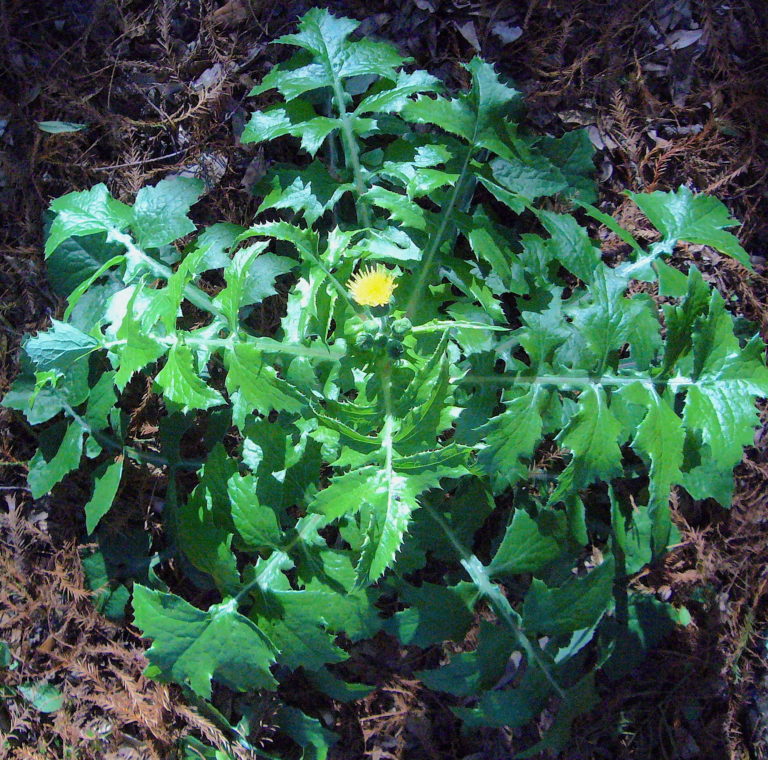
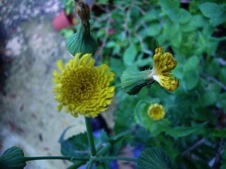
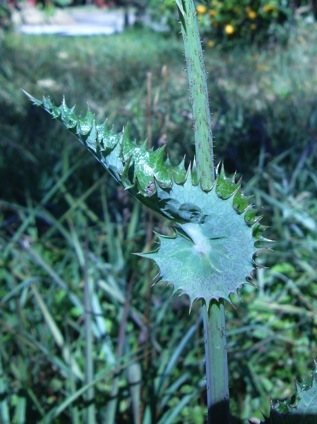
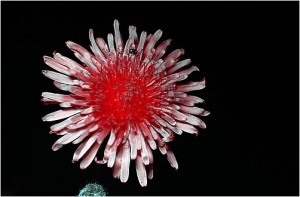
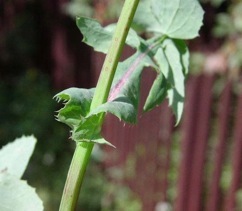

Hi, thank you for your article. I wonder where can I buy Purple sowthistle in USA. I live near San Francisco area. Thank you for letting me know. I want to buy.
wawa
thanks for writing… I have no idea the veracity of this sale, that is I don’t know if they have the right plant:
http://www.ebay.com/itm/4-Seeds-Sonchus-oleraceus-Hares-lettuce-Milk-thistle-/270690963196
I’ve been finding sow thistle to be positively delicious, my (latest) favorite weed. But, living in a big and dirty city, I can’t always trust the source. Do the seeds need special treatment before I try to plant them myself? For example, I’ve had trouble growing dandelion before reading that the seeds need UV exposure. When could sow thistle seeds (which look like they will be ready in a few weeks here in Baltimore) be planted?
Seeds from plants in poor places are generally safe to use. That has been the rule of thumb with speices seeds collected about railroad tracks. One you have frost free nights you can plant the slow thistles. Or start them inside.
we in australia know this as milk thistle. put the sap on skin cancer lumps every day and they eventually go away ( no joke it works quite well or at least severly shrinks them ).
I think this sow thistle gave me a horrible rash as I pulled 100’s of them from my flower garden,
Oleraceus is an understatement. Somehow, I had never tried sow thistles and they are absolutely first-rate delicious, boiled 10 minutes, with a little olive oil, balsamic vinegar, salt and pepper. (I find that even fairly long leaves from the upper half of a plant already in flower are quite mild, although these particular plants grew in partial shade.) Thanks as always GD!
Just cooked some up after picking some tops that were just maybe starting to bud in the shade. Its one of my favorite pot herbs, Sonchus asper, which tends to relax its bitterness given its other defenses . So I can saute it until it wilts instead of leaching in a boil like I often have to do with others in this family.
I have a couple similar plants that have most of the characteristics for sow thistles (hollow five sided stems, milky sap, rosette of leaves at base, clasping leaves on stem, stem branches into multiple sunflower like blooms) but the leaves are wrongly shaped. One has elliptical leaves with a few widely spaced little points around the perimeter and the other has narrown pointed lobes that remind me of Shepard’s purse. Any ideas?
A picture makes it so much easier…
Oh, and triangular petioles, no hairs.
Correct.
Hey Green Dean,
Is it alright to chomp on the unopened flowerheads? Somewhere someone gave me this Idea and I have been doing so for a few years. I don’t think I have died yet, and they are quite yummy in my opinion.
Is there any danger here?
As far as I know there’s no problem. If you like them have at them.
They do have a little bitterness to them, but also a bit nutty.
I just attended a foraging groups first meeting in my town {Davis CA} I am going to put a link to this article on their facebook.
Are there any verieties or poisonous look alikes for Sow Thistle? I have been endulging lately, and notice quite a bit of variety. In some area’s here I can find five or six types. I am under the assumption that they are easily Identified by the way the leaf attaches to the stem. And the bulb of the flower is gennerally the same. I think all the types I see here have a yellow flower…. Are there any to be wary of? {Before I spread the word to the club?}
They are in a family of some 22,000 members some of which are toxic but generally speaking there aren’t any close toxic look a-likes… and if you look close enough there aren’t any look a-likes.
Hi, I’ve heard about eating the unopened flowers. But I can’t find anything about the flowers themselves. Do you know if it is ok to eat the blowwomed yellow flowers?
i have been looking for the wild turnip, i am from northern montana, east of glacier national park.
Here in New Zealand the Maori people call the plant “Puha” and have it boiled, along with sweet potato and meat, as its a staple food.
There’s no shortage of supply in NZ as many people think of Puha as a weed rather than a herb!
Is the stalk of the spiny sow thistle? It is not too bitter and has a wonderful texture (a bit stringy though). am i taking a risk by eating it?
There is nothing wrong with eating the stalk of the spiny sow thistle (Sonchus asper) if you like it.
thank you
I’ve been eating these babies for the last 4 years now. I like them enough to actually take the time and trim the spine tips so I don’t have to boil them as long. After boiling I strain them. Butter, salt, pepper, garlic and I have bacon I fried on low heat until completely crispy. I break up the bacon into little bits and add it all in. Good eating.
They indeed are a very nice spring green.
Due to the drought last year, my lettuce did not produce well. I generally put the excess into smoothies. I had lots of sow thistle growing so used that. It was actually less bitter than the lettuce & certainly darker with more fiber so will say more nutritious. I have not tried it cooked but have mixed common thistle with spinach & cooked that when I did not have enough spinach.
Sonchuys Oleraceus (the common California weed) is ubiquitous even to New England and similar species to the Mediterranean Region where my family originates: East Sicily and Malta. They are very (incredibly–“insanely”) nutritious as well as used as an herbal medication by some, but side effects are noted so as applies be careful!
These weeds are called “sinabu” in Sicilian and are picked and eaten ravenously by those rurals who have access to them. They are similar to “broccoli rabe” and mustard greens, and they are placed in boiling water off heat and steeped without actively boiling for tenderness. The greens are eaten with olive oil and garlic and Italian Bread. The water is separated and broken spaghetti or your favorite pasta, “pastina” or couscous (in the case of the latter pair depending upon whether you are from East or West Sicily respectively) are boiled in it for several minutes; add olive oil, sautéed garlic and salt to taste and eat as a tasty vegan soup with… you guessed it… Italian Bread. It is a common Sicilian Lunch. ctt
Saturday, 26 March 2016; 11:02 PM
I grow canary island sonchus (sometimes called dendrosonchus) here in the uk and they are incredibly bitter! With the mos bitter being s. leptocephalus! That’s horrid!
When I need lettuce for a sandwich. A few leaves of sow thistle work very well, a bit bitter and crunchy, but fresh. The young top sprouts and blooms are good in a salad or as cooked greens with vinegar, onion and bacon. Good stuff.
Apparently there is a toxic similar looking plant: senecio vulgaris.
Doesn’t grow in as many areas, and the leaves are a different shape.
Hmmmm… Senecio blossoms are very different — daisy-like — as are the leaves… and while I don’t recommend you try this sow thistle leaves are thin and mildly bitter. Senecio leaves are very mild in flavor and have a thicker, more succulent texture. Do not eat them. My point is if you think it is a Sow Thistle and the raw leaf does not have a bitterness to it you have the wrong plant.
If they aren’t in flower yet, what’s the best way to tell Sonchus from Senecio vulgaris? Do the Senecio leaves lack the stem-wrapping bases?
Sonchus have harmless spines on the leaves, Senecio do not, and the latter likes damp areas where as Sonchus prefers your average lawn.
Can you eat the bloomed flowers? I was reading Florida’s Edible Wild Plants by Peggy Sins Lantz and it wasn’t clear on that topic.
Yes but flavor and texture can get in the way.
Can u drink the water found in a bull thistle stalk after u cut it in half?
Yes, as long as the plant grows in a wholesome area.
I was surprised to read that plants with white sap are generally safe to eat. Lots of euphorbias out there, milky sap, not edible, some dangerous if contact with skin or eyes! Like you said, identify first!
No… plants with white sap are generally not safe to eat. There are a few and of those few several a popular.
Have you heard of it being preserved like sauerkraut?
I have a bunch and would love to preserve some if it would work.
Hmmmm… I wonder how the white sap would behave or taste.
Hey Dan, is it safe for dogs to eat these?
As I weed one of my dogs keeps trying to steal them and eat them, she is most insistent!
As far as I know a little bit doesn’t harm dogs. I don’t know about a lot.
Thank you for this article! I have a bunch of these growing in my lawn, and now I know what to cook for dinner tonight.
I noticed you mention to typically avoid white berries in the wild. Have you ever eaten white beautyberries? I know the bright purple ones are edible but I can’t find much literature on the white ones.
Thanks!!
MS
I mention them on my article about beautyberries, on this website. White beautyberries are edible.
Audio started playing when I opened up this internet site, so irritating!
What a lying spammer you are. There is no audio on the site. NONE.
Your blog has the same post as another author but i like your better.~,`*`
probably AI, the internet is full of thieves. There’s a UK blog that stole the blog name if that’s what you mean. AI scraping websites are rather common these days.